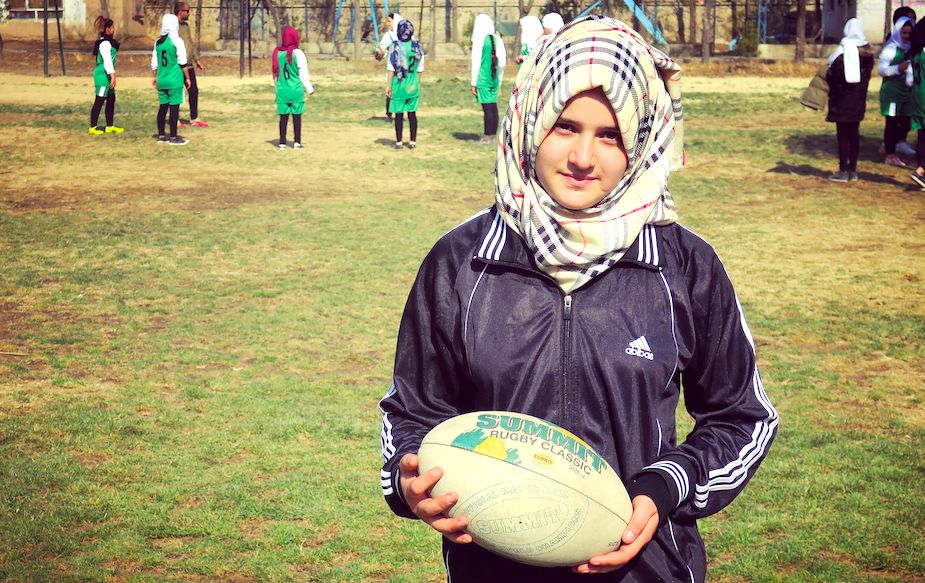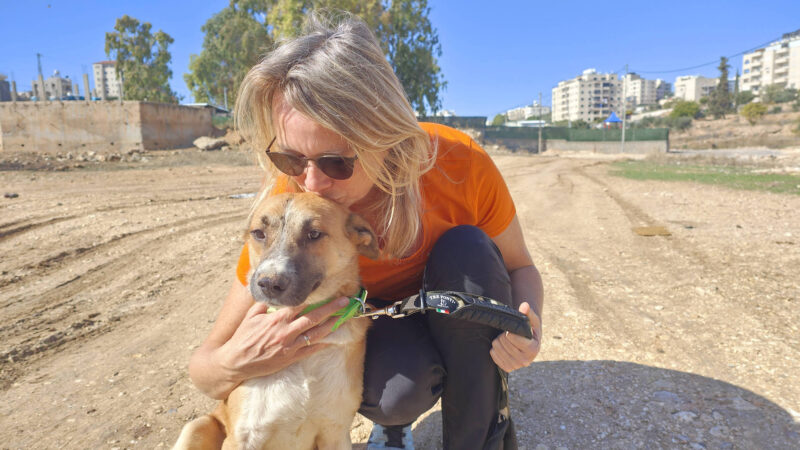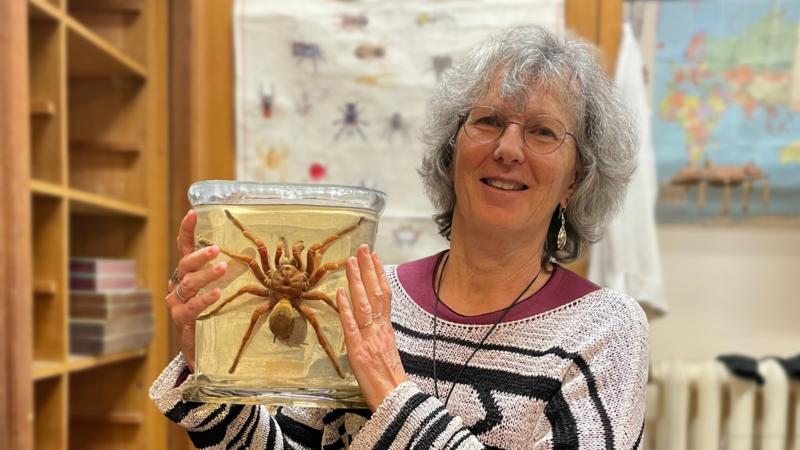Rugby is becoming increasingly popular at girls’ schools in Afghanistan. Possible injuries and sniggers from society do not deter the schoolgirls. They want to assert themselves and become role models for other young women – if it weren’t for one development that worries them.
By Veronika Eschbacher, Kabul
Mina Fedayi smiles briefly, embarrassed. “I lost consciousness three or four times,” says the 18-year-old Afghan. The slim, small woman is standing at the edge of a large lawn in the middle of the extensive grounds of a girls’ school in northern Kabul. But she is hardly stoppable. Her rugby team is playing.
It’s just a training session, but Fedayi is annoyed by all the questions she has to answer. She keeps running in the direction of the action, urging her team on with shouts and clenched fists. And returns quickly as soon as the sound of the coach’s shrill whistle cuts through the cold winter air and briefly interrupts the game.
Rugby is the latest sport to be introduced at girls’ schools in Afghanistan. For the second year now, around 200 young women at four schools in Kabul are practising this sport, which is not for the faint-hearted or squeamish. Many of the players have previously been in sports teams at their schools – playing football, volleyball or basketball. What they have in common is that they find rugby new and quite exciting.
The sports authorities in Afghanistan have recently focussed on less exciting and non-contact sports in order to get more women back on the teams after years in the doldrums: Table tennis, badminton or volleyball. The aim is to avoid controversy in what remains a very conservative society. There are probably few countries where girls and women have to overcome greater hurdles to take part in sport. Many social taboos stand in the way.
Feelings of happiness during training
Three times a week, rugby player Fedayi packs her sports kit in the dark so that she can be on the pitch at half past six in the morning – before school starts. “I’m so happy when I can train,” she says. All the responsibility for the household at home lies with her. “But no matter how tired I am, I always want to train,” she says, sprinting back towards the action.
The training is quite demanding: endurance paired with sophisticated technique. The athletes start to puff when it comes to tackling, i.e. when the ball carrier of the opposing team is to be stopped by holding her with their arms. If the tackle is successful, both players go to the ground. Among other things, this harbours the risk of the tackler’s head being crushed between the opponent and the ground. If a side tackle is badly timed, the opponent’s foot could land awkwardly in their own face.
The president of the national rugby federation, Haris Rahmani, has pushed for the introduction of women’s rugby in Afghanistan. It is important to him that there are also women’s teams. However, the fact that Fedayi and her team-mates can tackle, try (a spot kick, similar to a touchdown in American football) or convert (kick through the posts) is not a matter of course.
Pressure from many sides
Many of the obstacles for female athletes stem from social norms. Some Afghans consider any sport to be inappropriate for women. For others, the red line lies with contact sports such as martial arts or when the sport can only be practised in public spaces, such as road cycling. Parents often allow their daughters to do so, but are put under pressure by brothers, uncles or neighbours to forbid them again. Girls and young women in particular are afraid that they could injure their hymen during sport. Others see women’s sport as a symbol of Western imperialism that undermines the local culture.
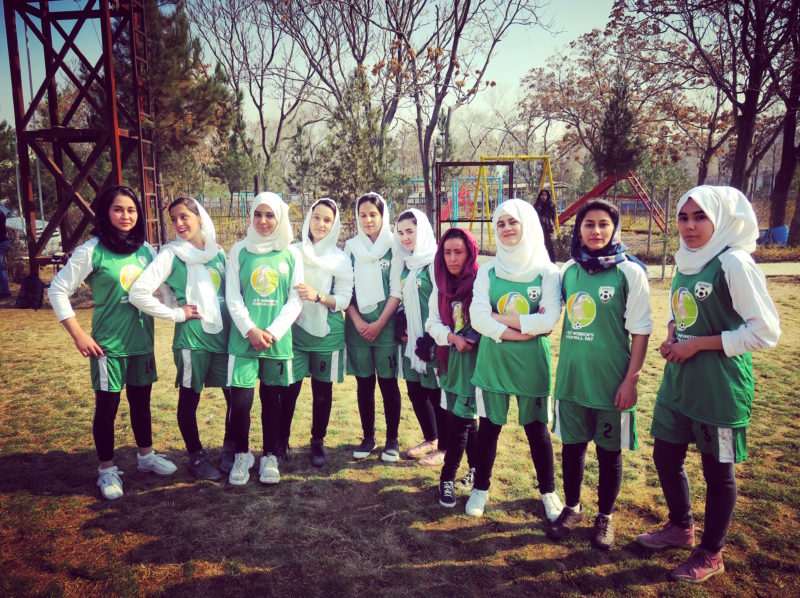
Girls’ schools are considered to be one of the safest places for sport, as they run more professional teams in addition to normal sports lessons, which often only involve walking around the school grounds. The schools are surrounded by thick, high walls that protect them from prying eyes. Quite a few girls keep quiet about it at home when they enrol in one of the teams – football, volleyball and basketball are the most popular.
They often say that they are taking an extra English course and secretly stuff their sports kit between their school books. But at the latest when they want to take part in tournaments, for example to make the national team, they have to come clean. It is impossible for a young woman to escape the close control of her family for a few hours. These tournaments are also repeatedly reported on in the local media.
Attacks are the order of the day
Despite ongoing peace talks between the insurgent Taliban and the Kabul government, attacks, battles and targeted killings continue to be a daily occurrence in Afghanistan. Sportswomen and sports facilities have been attacked by extremists in the past for defying social standards. However, the security situation – which is undoubtedly tense – is often used as an excuse to restrict women’s activities outside the home. At the same time, as in many other countries, women are verbally and sexually harassed in public. This is all the more true for women playing sport in public.
Other hurdles have to do with the infrastructure. There is a lack of suitable venues or equipment, especially in the provinces. The facilities for rugby are also modest. At Fedayi’s school, the only thing reminiscent of rugby is the ball. The game is played on the volleyball court. At least the national rugby federation provided the training kit.
Every time Fedayi puts on her pitch-black tracksuit, she remembers what she has learnt from the sport so far: a good attitude, courage and a lot of self-confidence, as she explains. “I may be small, but I’m really fast,” she says. She plans to study journalism. Winning competitions appeals to her, and she can also imagine a career in sport. But it is much more important to her to be a role model for other women: for those who are not allowed to do any sport.
Thus, her mantra is: “I want to give other women self-confidence.” For her, her father is her biggest role model, “because he always supports me in everything“. Her father is hence an example for those men in Afghanistan who fully support female athletes and their successes – and, more broadly, a change and opening up of society. Fedayi wants to continue with the sport as long as her family stands behind her.
Recognition for perseverance
According to an analysis by the Kabul-based think tank “Afghanistan Analysts Network” on women’s sport in Afghanistan, perseverance does pay off: those female athletes who persevere and excel would serve as role models who are recognised for their courage, strength and physical abilities. Nevertheless, women in sport – as a whole – are still a marginal phenomenon. However, reliable figures are not available in the war-torn country with a population of 33 million.
According to the “General Directorate of Physical Education and Sport”, an independent government organisation, their numbers have fallen in recent years. A recent survey of the national sports federations showed that of all the sports teams and clubs registered with the federations in the country, 98.5 per cent of the members are men – and therefore only 1.5 per cent are women.
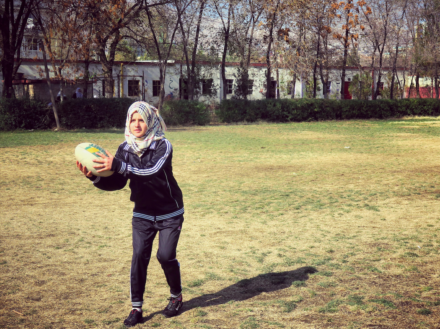
After the US invasion in 2001, which brought down the Taliban regime, women’s sport was pushed relatively quickly by international donor countries. The aim was to empower women through sport and improve their lives. Stories about the first skateboarding girls, women’s cycling teams or Taekwando fighters were picked up by many media in the West and the women practising sport were celebrated as a success.
Over time, as the Afghanistan Analysts Network goes on to analyse, the sportswomen have become a symbol of change, representing hope for a more egalitarian society with greater opportunities for girls and women. At the same time, however, a number of scandals followed: several women’s sports teams were accused of corruption, some of which were spectacular. Officials are said to have helped themselves to the funding pots or tried to profit from donated equipment. They had little interest in the development of women’s sport.
Women’s sport reached another low point at the end of 2018 when several players from the national women’s football team accused the head of football, Keramuddin Karim, of sexual and physical abuse. Karim was banned for life by football’s world governing body Fifa shortly afterwards. The case was also widely discussed in the Afghan media. Colleagues of rugby player Fedayi say that they had problems in their families afterwards and were asked to give up the sport again. They had to talk a lot with their families to regain their trust.
There’s growth again – but for how long?
Officials currently see women’s sport on the upswing again, despite the difficult past few years. A spokeswoman for the Afghan Olympic Committee says that the number of female athletes has recently increased. “We now have more women in more different kinds of sports,” explains Benafsha Faizi. The Olympic Committee supports programmes to find talent, including tournaments at schools and universities or national sports competitions.
The Rugby Federation also held its first tournament to select the women’s national team in November 2020. It has not yet been officially announced who will be included in the team – but the national coaches say that Fedayi was one of the best players. However, due to the coronavirus pandemic, it remains to be seen when training with the national team will begin. There is no professional league for women anyway. Rather, the Rugby Federation says that the rugby programme in girls’ schools should be expanded first.
How long the expansion of women’s sport will last and Mina Fedayi will be able to tackle each other with her team-mates early in the morning is uncertain. In the Gulf emirate of Qatar, negotiations between the government in Kabul and the insurgent Taliban have been ongoing since September. The aim is to reach a peace agreement after 20 years of bloody conflict and also to decide what life in Afghanistan should look like in the future. Many are afraid that the wheel of time could be turned back and the achievements of recent years in the area of women’s rights could disappear into thin air.
“I expect the negotiations not to forget the young women and sportswomen,” says Fedayi. The negotiators from both parties to the conflict should take into account how they have lived in recent years. However, should the Islamists actually become part of the government, rugby player Fedayi is not optimistic. Does she think she would be able to continue playing sport? She clicks her tongue in disapproval. “No,” she says, and stands still for the first time before sprinting back to her position.

